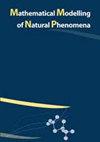Study of architectural forms of invasive carcinoma based on the measurement of pattern complexity
IF 2.1
4区 数学
Q2 MATHEMATICAL & COMPUTATIONAL BIOLOGY
引用次数: 1
Abstract
Several years ago, a new paradigm of cancer perception emerged, considering a tumor not as a senseless heap of cells but as a self-organizing heterogeneous tissue of cancer cells that collectively fight for survival. It implies that the architectural forms that a tumor takes during its growth are not occasional but are a synergistic response of a group of cancer cells in competition for the organism’s resources. In this work, we generate various patterns of a two-dimensional tumor using our previously developed individual-based model mimicking carcinoma features. Every cell is represented by a polygon dynamically changing its form and size. The dynamics of tissue are governed by the elastic potential energy. We numerically obtain various patterns of carcinoma and estimate empirical spatial entropy and complexity measures applying the approach based on the fast finite shearlet transform. We show how the complexity of growing carcinoma changes over time and depending on the values of the cell intercalation parameters. In each case, we give a rational explanation of why this form is beneficial to the tumor. Our results show that one can use complexity measurements for quantitative classification of tumors obtained in silico , which potentially could find its application in practice.基于模式复杂性测量的浸润性癌结构形态研究
几年前,一种新的癌症认知模式出现了,认为肿瘤不是一堆毫无意义的细胞,而是癌症细胞的自组织异质组织,它们共同为生存而斗争。这意味着肿瘤在生长过程中所采取的结构形式不是偶然的,而是一群癌症细胞在争夺生物体资源时的协同反应。在这项工作中,我们使用之前开发的模拟癌症特征的基于个体的模型生成了二维肿瘤的各种模式。每个单元都由一个多边形表示,该多边形动态地改变其形状和大小。组织的动力学是由弹性势能决定的。我们用数值方法获得了各种癌症模式,并应用基于快速有限剪切变换的方法估计了经验空间熵和复杂性测度。我们展示了生长中的癌症的复杂性如何随时间变化,并取决于细胞嵌入参数的值。在每种情况下,我们都会合理地解释为什么这种形式对肿瘤有益。我们的研究结果表明,可以使用复杂性测量对在计算机上获得的肿瘤进行定量分类,这可能会在实践中得到应用。
本文章由计算机程序翻译,如有差异,请以英文原文为准。
求助全文
约1分钟内获得全文
求助全文
来源期刊

Mathematical Modelling of Natural Phenomena
MATHEMATICAL & COMPUTATIONAL BIOLOGY-MATHEMATICS, INTERDISCIPLINARY APPLICATIONS
CiteScore
5.20
自引率
0.00%
发文量
46
审稿时长
6-12 weeks
期刊介绍:
The Mathematical Modelling of Natural Phenomena (MMNP) is an international research journal, which publishes top-level original and review papers, short communications and proceedings on mathematical modelling in biology, medicine, chemistry, physics, and other areas. The scope of the journal is devoted to mathematical modelling with sufficiently advanced model, and the works studying mainly the existence and stability of stationary points of ODE systems are not considered. The scope of the journal also includes applied mathematics and mathematical analysis in the context of its applications to the real world problems. The journal is essentially functioning on the basis of topical issues representing active areas of research. Each topical issue has its own editorial board. The authors are invited to submit papers to the announced issues or to suggest new issues.
Journal publishes research articles and reviews within the whole field of mathematical modelling, and it will continue to provide information on the latest trends and developments in this ever-expanding subject.
 求助内容:
求助内容: 应助结果提醒方式:
应助结果提醒方式:


